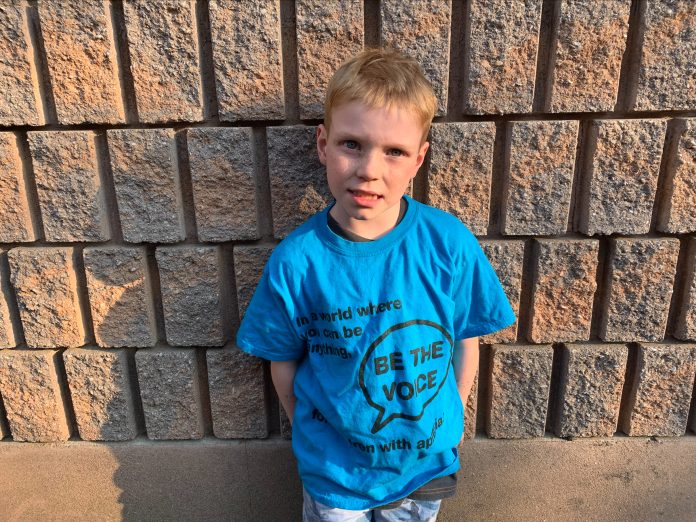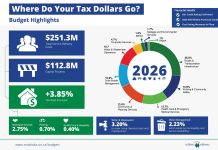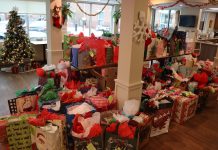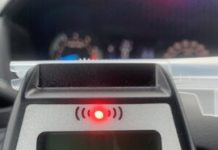It’s been five years since Bracebridge resident Jody Hamilton found out her son Nash had apraxia, and in that time, she’s made it her mission to raise awareness about the motor speech disorder.
Childhood apraxia of speech (CAS) is a rare neurological disorder that affects a child’s ability to speak. People with apraxia know what they want to say but struggle to perform the complex movements required to form words. It’s a condition that persists into adulthood and requires extensive therapy to address. May is Apraxia Awareness Month and on May 14, supporters will wear blue and landmarks like the Bracebridge Falls will bask in blue light to raise awareness and funding for the disorder.
“[Nash] communicates very differently, but that’s okay. He really shouldn’t be treated any differently,” Jody said. “Everybody should be inclusive, and if they’re not quite sure about what to do or how to act, ask somebody and educate yourself.”
Jody initially thought her son Nash was just a calm and quiet baby, but eventually, she noticed that he wasn’t reaching the same speech milestones as other children his age. After consulting with his doctors, they were referred to the children’s healthcare centre One Kids Place where he was diagnosed with CAS at two years and eight months.
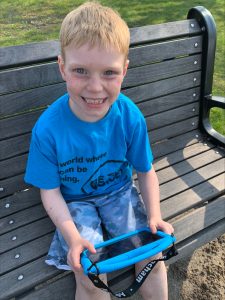
Now, Nash is seven years old and in Grade 1. He continues to do speech therapy and works on his speech at school for 20 minutes every day.
“He’s definitely come a long way,” Jody said. “He’s talking in probably about eight- to ten-word sentences now. Depending on if someone is familiar with him or not, he’s kind of anywhere between 30 and 60 per cent intelligible.”
The transition from senior kindergarten to Grade 1 meant moving away from play-based learning. The greater emphasis on reading and writing skills has posed a challenge for Nash, she said. Like most children, Nash tries to work out spelling by sounding out words, but due to his apraxia, certain sounds can get lost in translation.
If he tries to say dog, for example, he often says “dod” instead. He knows the word ends in a G, but because he struggles to pronounce it, he will sometimes write “dod” as well since that’s the sound he’s making.
To help address his speech difficulties, he has a tablet that acts as an augmentative and alternative communication (AAC) device, helping him talk to others and sound out words. They call it his “helper” and though he’s had it for years, it’s become increasingly important as he works on reading and writing.
“We were told from a young age that it would just be a little bit more difficult for him, but we’re making it work and making the best of it,” Jody said. “The school has been fantastic.”
Because May 14 falls on a Sunday this year, students and teachers at his school will be dressing up in blue the Friday before. Jody will also be attending an assembly to give a full presentation on apraxia, and it’s the first year she’s been able to do so since 2019.
At the beginning of the school year, she went into Nash’s class and read a book to help his classmates understand apraxia, so the assembly will be a chance to spread that message to the rest of the school. Most people know about his disorder since it’s a fairly small school, but the assembly will go more in-depth on the invisible disability and give people insight into how to respond to people with CAS.
“I need to give Nash 10 extra seconds to be able to try and focus and figure out what he wants to say compared to you and I where we don’t need to think about it,” Jody said. “Nash needs to plan everything he needs to talk about, so I think it’s good for young and old [to get educated about apraxia].”
Along with spreading awareness across Muskoka, Jody helps Apraxia Kids Canada by acting as a moderator for their Facebook group. She also regularly coordinates with board members, and she hopes to attend their annual conference this year. In September, the organization hosts a Walk for Apraxia, so Jody also hopes to work with other local families affected by apraxia to bring the walk to Muskoka someday.
Through her years of advocacy, one of the most exciting parts has been watching Nash start to advocate for himself. It’s been fantastic to see his progress, she said, and it makes her emotional to think about the way he’s managed to share his story with others.

“He has that confidence now that he can say, ‘Me need more time, me need more time,’” she said. When other kids ask blunt questions like “Why do you talk funny?”, he responds by trying to educate them. “Nash will just say, ‘No, me have apraxia.’ He’ll literally say, ‘Me brain and me mouth no work properly all the time.’”
It’s been wonderful for her to see how receptive people are to learning about apraxia, but even more impactful than that, her advocacy has connected her to other people in the area who are going through the same thing. When Nash was diagnosed with apraxia, she had never heard of it and didn’t know anyone in the region who was facing the same challenges.
Now, she knows four Muskoka families that have children with apraxia, providing a support system for parents and kids alike. Though CAS remains rare with only about 1 in 1,000 children affected by the disorder, more and more children in Muskoka are being diagnosed as local awareness and education improves. She hopes the increased understanding of apraxia will help people be inclusive and remember to take the time to listen to Nash and other kids like him.
“Just because Nash doesn’t say much sometimes doesn’t mean that he doesn’t want to be heard.”
To learn more about childhood apraxia of speech, visit the Apraxia Kids’ website.


